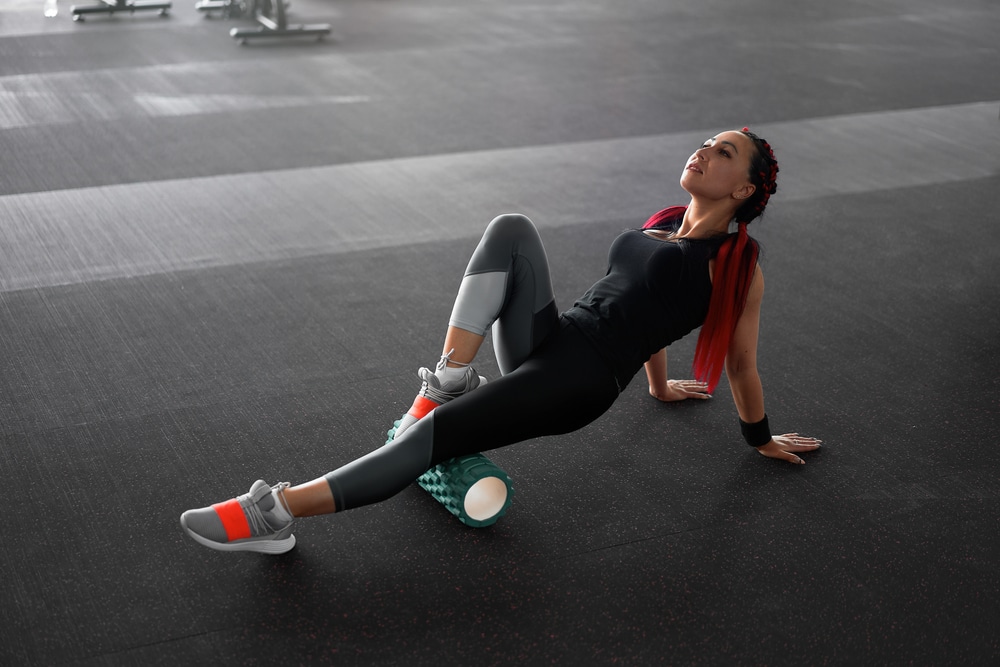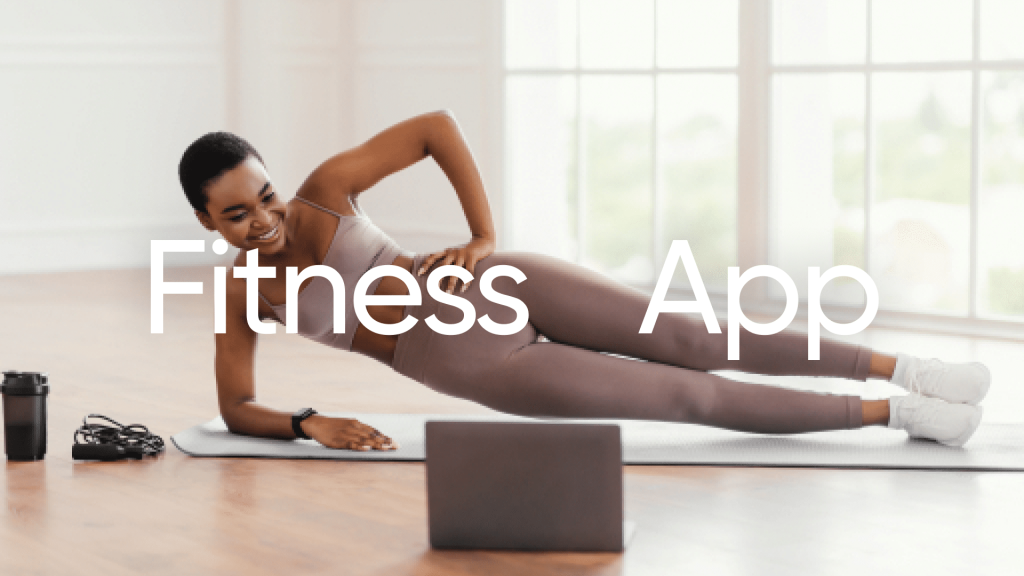A tight muscle here, an achy joint there– it’s no wonder people are always on the lookout for new ways to ease their pain. This is where foam rolling enters the picture. It is a form of self-myofascial release that’s been gaining in popularity as an easy and affordable way to help reduce muscle tension and pain.
Get your personalized
meal plan!
You might be thinking this is a trend that won’t last, but foam rolling has been around for centuries. It was originally used by physical therapists to help people recover from injuries, and today it’s still a popular treatment among them.
There are many benefits to foam rolling, which we’ll discuss in this article. We’ll also give you some tips on how to do it correctly, so you can experience all of the benefits for yourself.
What Is Foam Rolling?
Foam rolling is a form of Self-Myofascial Release (SMR), which is a fancy way of saying that you’re using your own body weight and gravity to help massage and stretch your muscles (11).
When you foam roll, you’re using a cylindrical piece of foam to apply pressure to your muscles. This pressure helps break up the fascia (the connective tissue that surrounds and supports your muscles) and release tension and knots.
This can be a very effective way to reduce muscle tension and pain, and can also help improve flexibility and range of motion.
Benefits Of Foam Rolling
There are many benefits to foam rolling, including:
- Reduced muscle tension and pain
- Improved flexibility and range of motion
- Enhanced performance
- Reduced risk of injury
Let’s take a closer look at each of these benefits!
Reduced Muscle Tension And Pain
Foam rolling is a great way to reduce muscle tension and pain. The pressure and massage from the foam roller help break up the fascia, release tension, and reduce knots (8). This can help improve flexibility and range of motion, as well as reduce the risk of injury.
Read More: Firefighter Fitness Program: Everything You Need To Know
Improved Flexibility And Range Of Motion
Foam rolling can help improve flexibility and range of motion by releasing tension and knots in the muscles.
When the muscles are loose and flexible, they can move through their full range of motion with ease (6). This can help you move more freely and achieve a greater range of motion in your everyday activities.
Enhanced Performance
Foam rolling can also help to improve performance (2).
The improved flexibility and range of motion can allow you to move more freely and with greater efficiency. And the release of tension and knots can help you to perform at your best without feeling pain or restriction.
Reduced Risk Of Injury
Foam rolling can help to reduce the risk of injury (10). The release of tension and knots can help to improve your range of motion and flexibility, which can help you to move with greater ease and less risk of injury.
And the massage from the foam roller can help to support and strengthen your muscles, making them less likely to become injured.
Temporarily Reduced Appearance Of Cellulite
Cellulite is the appearance of dimpled skin, typically on the thighs and buttocks. While there is no one definitive cause of cellulite, it is often attributed to factors such as genetics, hormones, diet, and level of activity (9).
While there is currently no cure for cellulite, there are a few ways to temporarily reduce its appearance. One such method is foam rolling. When performed regularly, foam rolling can help reduce the appearance of cellulite.
This is because foam rolling helps increase blood flow and circulation to the muscles, ligaments, soft tissue, and fascia (1). This in turn helps break down fatty deposits and improve the appearance of the skin.
Furthermore, foam rolling can help loosen and break up the fascia (connective tissue) that surrounds the muscles. This can also improve the appearance of cellulite, as fascia can contribute to its formation.
However, it is important to note that foam rolling is not a cure-all for cellulite. It may take several weeks or even months of regular foam rolling before any noticeable changes are seen.
Reduced Back Pain
Back pain is caused by many different factors, from injury to poor posture. Regardless of the cause, one thing is for certain: it can be incredibly frustrating and debilitating.
While there are several treatments available for back pain, such as medication or surgery, some people may find that they need to look for alternatives. If this is you, consider using foam rolling as a way to ease your pain (4).
Foam rolling can be used to release muscle tension and knots in the back area. When used regularly, it can help to improve flexibility and range of motion, as well as reduce inflammation and pain (3).
In addition, self-myofascial release with a foam roller has been shown to improve back pain and function in people with chronic low back pain.
A word of caution-it’s easy to strain or injure your back further while using a foam roller. You must be careful when rolling out your back and always consult with a healthcare professional if you are unsure about whether foam rolling is right for you.
With that said, here are a few tips to help get you started:
- Start by lying on your back and placing the roller under your spine.
- Gently move up and down the roller, using your hands to apply pressure as needed.
- Roll from the base of your spine to the top of your neck.
- Stop if you feel any pain or discomfort.
- Repeat as needed.
Foam rolling can be a great way to manage back pain, but it’s important to do it safely.
Reasons why BetterMe is a safe bet: a wide range of calorie-blasting workouts, finger-licking recipes, 24/7 support, challenges that’ll keep you on your best game, and that just scratches the surface! Start using our app and watch the magic happen.
Help Manage Fibromyalgia Symptoms
Fibromyalgia is a condition that is characterized by widespread musculoskeletal pain, fatigue, and tenderness in certain areas of the body (7).
While there is no known cure for fibromyalgia, treatments can help manage symptoms. One such treatment is foam rolling.
Foam rolling helps manage symptoms in several ways (5). First, it helps to improve flexibility and range of motion. Second, it helps to improve blood flow and circulation, which can help to reduce pain and fatigue.
Third, it helps to improve muscle tone and strength. Fourth, it helps to promote relaxation and stress relief.
If you suffer from fibromyalgia, talk to your doctor to see if foam rolling is right for you.
Types Of Foam Rollers And How To Choose The Best One
There are many different types of foam rollers on the market, including:
Smooth Rollers
These have a smooth, dense surface and are best for general use. They are good for all body parts but are especially effective for the quads, hamstrings, and IT band.
Grid Rollers
These have a grid-like surface and are best for targeting specific areas of the body. They are good for Trigger Points and Myofascial Release.
Firm Rollers
These have a firm surface and are best for a deep-tissue massage. They are good for the back, glutes, and calves.
Foam Massage Balls
These are small, round balls made of foam. They are best for targeting smaller areas of the body, such as the neck and shoulders.
When choosing a foam roller, it is important to consider your needs and goals. If you are unsure which type of roller is right for you, start with a smooth roller and then upgrade if needed.
Read More: Nordic Walking Benefits: 10 Plus Reasons To Try This New Fitness Trend
How To Do Foam Rolling Correctly?
Now that you know the benefits of foam rolling, let’s take a look at how to do it correctly.
Here are some tips:
- Start with light pressure and work your way up gradually.
- Focus on specific muscles or muscle groups, and roll them for about 30 seconds.
- Roll slowly and pause for a few seconds on any knots or tight areas.
- Breathe deeply and relax into the massage.
- If you experience any pain, stop immediately.
Foam Rolling Mistakes To Avoid
There are also a few foam rolling mistakes to avoid, including:
- Rolling too quickly or applying too much pressure. This can cause pain and discomfort.
- Focusing on the wrong muscles. Foam rolling should be targeted, so make sure to focus on the right muscles.
- Not relaxing into the massage. The benefits of foam rolling are only realized if you relax and let the massage do its job.
- Not breathing deeply. Breathing deeply will help relax your muscles and increase the benefits of the massage.
- Not drinking enough water after rolling. Foam rolling can cause muscles to swell, so it’s important to drink plenty of fluid for optimal functioning and recovery of muscles (12).
- Rolling over knots and painful spots. This can aggravate the problem and cause pain. Instead, you should roll surrounding muscles that are not as tight.
- Not doing it consistently. Like most physical activities, foam rolling requires consistency to see results. Try to roll every day for the best results.
BetterMe app will provide you with a host of fat-frying fitness routines that’ll scare the extra pounds away and turn your body into a masterpiece! Get your life moving in the right direction with BetterMe!
The Bottom Line
Foam rolling can be a great way to improve flexibility, range of motion, and performance. It also reduces the risk of injury. It is important to do foam rolling correctly, so make sure to follow these tips. In case you experience any pain or discomfort, stop immediately.
DISCLAIMER:
This article is intended for general informational purposes only and does not serve to address individual circumstances. It is not a substitute for professional advice or help and should not be relied on for making any kind of decision-making. Any action taken as a direct or indirect result of the information in this article is entirely at your own risk and is your sole responsibility.
BetterMe, its content staff, and its medical advisors accept no responsibility for inaccuracies, errors, misstatements, inconsistencies, or omissions and specifically disclaim any liability, loss or risk, personal, professional or otherwise, which may be incurred as a consequence, directly or indirectly, of the use and/or application of any content.
You should always seek the advice of your physician or other qualified health provider with any questions you may have regarding a medical condition or your specific situation. Never disregard professional medical advice or delay seeking it because of BetterMe content. If you suspect or think you may have a medical emergency, call your doctor.
SOURCES:
- Acute Effects of Self-Myofascial Release Using a Foam Roller on Arterial Function (2014, journals.lww.com)
- A Meta-Analysis of the Effects of Foam Rolling on Performance and Recovery (2019, frontiersin.org)
- An Acute Bout of Self-Myofascial Release in the Form of Foam Rolling Improves Performance Testing (2014, ncbi.nlm.nih.gov)
- Back Pain (2022, ncbi.nlm.nih.gov)
- Benefits of a self-myofascial release program on health-related quality of life in people with fibromyalgia: a randomized controlled trial (2017, pubmed.ncbi.nlm.nih.gov)
- COMPARING THE EFFECTS OF SELF‐MYOFASCIAL RELEASE WITH STATIC STRETCHING ON ANKLE RANGE‐OF‐MOTION IN ADOLESCENT ATHLETES (2015, ncbi.nlm.nih.gov)
- Fibromyalgia – StatPearls – NCBI Bookshelf (2021, ncbi.nlm.nih.gov)
- Foam Rolling for Delayed-Onset Muscle Soreness and Recovery of Dynamic Performance Measures (2015, ncbi.nlm.nih.gov)
- Insights Into the Pathophysiology of Cellulite: A Review: Dermatologic Surgery (2020, journals.lww.com)
- Preventive and Regenerative Foam Rolling are Equally Effective in Reducing Fatigue-Related Impairments of Muscle Function following Exercise (2017, ncbi.nlm.nih.gov)
- The Effects of Myofascial Release With Foam Rolling on Performance (2014, journals.lww.com)
- The Role of Water Homeostasis in Muscle Function and Frailty: A Review (2019, ncbi.nlm.nih.gov)












